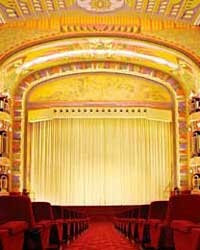 From Hollywood to Shanghai, the show must go on at these old-time movie theaters.
From Hollywood to Shanghai, the show must go on at these old-time movie theaters.
See our slideshow of the Best Vintage Movie Theaters.
In the 1920s—back when people dressed up to see the latest Hollywood feature—movie palaces resembled cathedrals. They lured moviegoers with polished-marble foyers, ceilings glowing with tiny starlike lights, hand-painted murals, costumed ushers, and—the pièce de résistance—dramas unfolding on the screen like a cast spell.
Unfortunately, many of the world’s grandest movie palaces have gone the way of silent films—nobody’s making them anymore, and very few have survived in the era of TiVo and Netflix. Luckily, though, there are still a few operating vintage movie houses scattered around the globe—some in some very unlikely places.
Many still-in-business movie palaces have stayed competitive by keeping their vintage eye-candy interiors but adopting today’s must-have technology (including digital surround-sound speakers, gynormous screens, and blizzard-cold air-conditioning). Others have expanded their repertoires to include more than just movies: for example, at Le Grand Rex, a glamorous Mediterranean-themed theater in Paris, film screenings alternate with a calendar of concerts by famed performers (Bob Dylan and Björk among them).
What’s wonderful about old theaters, says Mike McMenamin, co-owner of a handful of palace theaters in the American northwest, is that, as well as giving moviegoers a taste of old-school grandeur, each venue has a unique history. “Often the stories of the theater can eclipse the stories on screen,” he says. At his Bagdad Theater & Pub, in Portland, Oregon, those stories include a lavish 1927 grand opening, where Carl Lamail, then president of Universal Studios, brought a live camel to accompany him on the red carpet.
A battered economy may leave many palace theaters struggling, but it’s worth noting that even in the poorest days of the Great Depression, 60 to 80 million Americans continued going to movies regularly. “At that moment in American cultural history,” says Ross Melnick, cofounder of theater-tracking organization Cinema Treasures, “we viewed entertainment and the news together every week—not five times a year (the current average movie attendance today).”
Founded in 1999, Cinema Treasures has a Web site that lists 23,000 vintage theaters (hundreds demolished, but many still aglow) in more than 175 countries. Melnick’s organization and others like it are fighting to keep palace theaters up and running, but regular ticket buyers are equally—if not more—important. True, a film may look the same at the chain theater down the street, but there’s something about settling into a velveteen seat, in the same place where a generation first laughed at Chaplin’s madcap antics or shed a tear during Casablanca, that gives palace theaters a starring role.